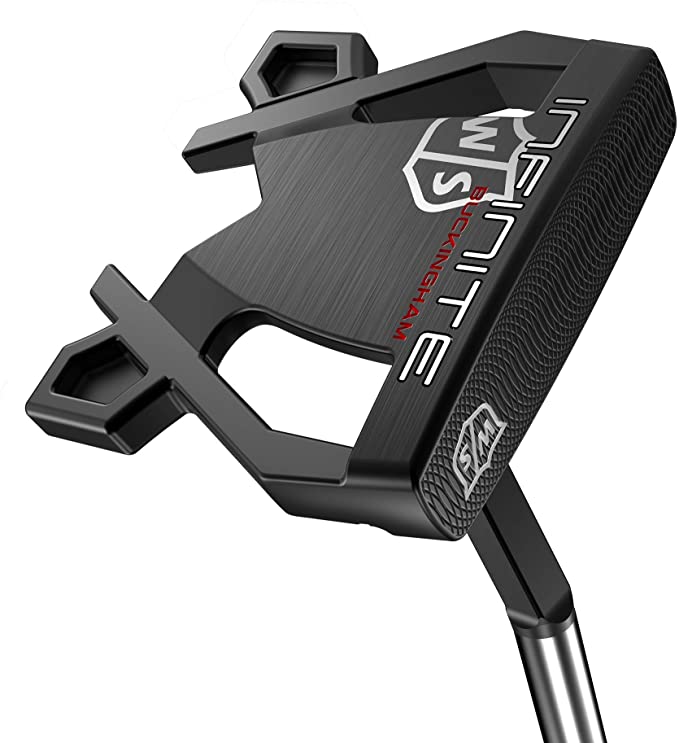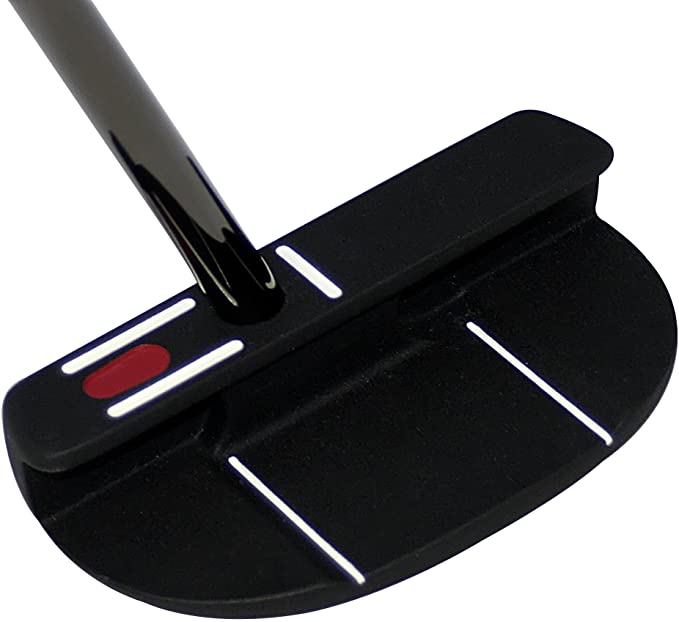Picking out a putter requires careful consideration of many different factors. The best putter for beginners is one that offers consistency, a high level of performance, and total comfort. These clubs come in all different shapes and sizes and can be overwhelming for a new golfer.
We’re using the guide below as a way to educate beginner golfers and help them pick out different putters, an arm lock putter or any other type, that will save them countless strokes over the course of time. One thing we want to drive home before we start, a putter will last longer than any club in your bag. People swap drivers, irons, and wedges out constantly, but not putters.
By doing research and making sure to pick out a putter that suits your game, you’re setting yourself up for more than 10 years of putting stroke consistency and exceptional performance.
Odyssey Golf 2021 White Hot OG Putter
A nice blade putter with a classic design isn’t exactly hard to come by, the Odyssey White Hot OG separates itself from the competition. In this case, simplicity reigns supreme with just two alignment lines. One to center the ball and another to keep the club square.
For a beginner golfer, you need to clear your mind and focus on making good contact. This putter lends itself to that mindset without any unnecessary frills.
Thanks to the offset shaft and crank hosel, weight shifts away from the heel and has significant toe hang. This weight distribution makes the Odyssey White Hot OG a great choice for amateur golfers struggling to maintain a straight putting stroke.
You can find a more expensive putter and you can find a less expensive putter. What makes this a great investment for a beginner golfer is the combination of quality and value. Of top-tier putter brands, Odyssey is on the affordable side and the White Hot OG has a strong reputation of durability, plus you can replace the face insert should it ever begin to wear down.
WILSON Infinite Buckingham Men's Golf Putter
Our choice for amateur golfers with precise speed control and a controlled stroke is the Wilson Infinite mallet putter.
The Wilson Infinite putter line has been successful due to their advanced alignment guides and distinctive design. Not only are their multiple vertical alignment lines, but perpendicular too. When you’re standing over a putt, it’s impossible not to identify when your address is even slightly off.
With the mallet head, weight shifts away from the toe towards the heel and has a balanced feel. Even varying contact will give consistent ball speeds off the face. All these factors come together to make even the most novice players feel like professional golfers on the green.
SeeMore FGP Black Mallet Putter
A lot of beginner golfers struggle with lining up their putts. Even when they have the correct line, incorrect address prevents a consistent roll and overall accuracy. These golfers need alignment correction, and there is no easier method than a SeeMore FGP putter.
SeeMore putters do not have an offset shaft, but for a good, very practical reason. On top of the putter head, tucked behind where the shaft meets the head is a red mark. If this red mark is visible, your putter is open or closed. Once you adjust and the red is no longer visible, you are square.
SeeMore putters train the eyes of beginner golfers and help them develop good habits. They don’t guarantee a perfect stroke, but will put you in a position to succeed.
What to Consider When Choosing a Putter for a Beginner
Mallet vs Blade
Golf putters have a wide variety of shapes and sizes, but really only two main categories, mallets and blades.
A mallet putter has a rounded back and has a very even weight distribution. Because of the large head surface, mallet putters can have exciting designs that also help with aim and lining putts up. Two common mallet design is the “two-ball” or “spider” style. With advanced weight distribution, the “sweet spot” on a mallet putter spans just about the entire face.
A blade putter is more traditional than a mallet. They almost always have a square back, with a rectangle type design and more concentrated weight distribution. The putter head goes back an inch or two from the face and will have some type of aim guide, but nothing more than a line or two. Blade putters have a smaller sweet spot, but more versatility when it comes to ball roll.
Putter Length
Proper putter length is related to height, with most putters built between 33 and 35 inches.
- If you’re 5’8” and shorter, go with a 33-inch putter.
- If you’re between 5’9” and 6’, go with a 34-inch putter.
- Any golfer over 6 feet should be using a 35-inch putter.
If you’re well over six feet tall and do not feel comfortable with a 35-inch putter, certain brands make stock putters 36-inches and longer, but buying one this length might mean having to go with your second or third choice. The same goes for right-handed golfers versus left-handed golfers. Right-handed golfers will always be at an advantage buying a new putter.
Like most things in golf, don’t be afraid to go with what’s most comfortable. We can advise against a 6’5” golfers using a 33” putter, but if that’s what you used for a decade and putt well, it’s okay to make your next putter that length too.
Weight
Beginner golfers do not need to concern themselves with putter head weight. What you buy is what you’ll use.
Some golfers argue that additional weight helps them with firmer putters on slower greens. Others will claim that adding extra weight just gives them a better feel. If you’re one of these people and the package weight isn’t cutting it, a piece of lead tape could help.
Balance
Putters are balanced two ways, with toe hand or balanced. If you’re able to balance the club so that the face sits parallel to the ground, that’s a face-balanced putter. If you try to balance it the same way and the face hangs towards the ground, that’s a toe hang putter.
If you struggle with a straight putting stroke, you might want to give a putter with toe hang a try as it helps correct this. If you have a consistent stroke, a face balanced putter is the way to go as you will benefit from the larger sweet spot.
Putter Grip
Plenty of amateur golfers that struggle with stroke consistency use thick and oversized grips. This style prevents you from breaking your wrists, leading to a controlled stroke and more consistent performance.
More traditional grips provide “feedback” on each putt, meaning you can feel each putt. Just like with a driver, you’ll know if you hit it on the sweet spot or not.
If you have a perfect stroke, choose whatever type of grip you’re more comfortable with.
Alignment of the putter
Alignment lines are essential for amateur golfers. Unless you’re on the PGA Tour, you need some help squaring the ball on your putter—and even those players need help too.
With an alignment aid, it is easier to get consistent roll and adjust for green speeds. More consistent contact leads to better control over time.
Putter Face
You will not find a putter with a smooth ball-striking surface. Putter faces have designs for the same reason golf balls have dimples. Some of this is aesthetic, but it also serves a valuable purpose, control.
A mishit with a smooth faced putter can be disastrous. With a milled face, you have more control. Whether you choose an expensive putter or not, it will always have a milled face.
Face inserts
If you use your putter for a decade (or just practice way too much), your putter face will wear down. When this happens, your once legendary performance might suffer and you will not have true roll. The closest comparison is bouncing a ball on pavement versus gravel. Both balls will still bounce up, but will be harder to catch again on an uneven surface.
Some putters, like the Odyssey White Hot OG above, have face inserts that can be replaced. Properly done, this process will make your putter like new again.
Loft
A putter, by rule, is prevented from having a loft above 10-degrees. Most putters you’ll find online or in a store come with between 3 and 4-degrees of loft. If you’re a beginner golfer, you’re going for a forgiving putter and worrying about fractions of degrees is not worth the trouble.
If there were no loft or negative loft on your putter, it would be difficult to advance the ball smoothly. With a small amount of loft, your putting stroke lifts the ball ever so slightly off the ground before it begins its roll.
Lie
Putter lie refers to the angle at which your putter shaft meets the putter head. If a putter shaft goes straight down into the putter head, it would have a lie of 90-degrees. Most putters off the shelf have a lie of about 70.
Lie angle matters, but not much to a beginner golfer. When you’re in the process of developing your putting stroke, you should be focused on moving it straight back and forth and learning control. Choose a putter that falls in the middle of the lie spectrum. You’ll learn to putt with whatever you buy.
FAQ
What type of putter should a beginner use?
A beginner with a pendulum-like putting stroke can use a blade or mallet. If you struggle with going straight back and straight forward, a blade will help correct this.
What is the most forgiving putter?
Mallets tend to be more forgiving, but green speeds play a bigger role in forgiveness than any one putter. Be mindful of extra slow or fast greens.
What is the best putter for a high handicapper?
One that makes putts. In all seriousness, a high handicapper needs to be comfortable with their putter. Make your choice, practice, and that’s the best putter for you.
What is the Easiest Putter to Line up?
We like SeeMore putters for this reason. There is a clear indicator whether your setup is good or bad.
What Putter Should You Avoid Totally?
Avoid gimmicky putters like one that stands on its own, will read greens for you, or anything else that makes guarantees. Golfers make the putts, not their clubs.
What is the easiest putter to use?
The easiest putter to use for beginner golfers is one without any wasted design features. You don’t want to be overwhelmed by a design and end up thinking of too many things. Simple is good.
Are heavier putters better?
Heavier putters will help you stay down on putts. If you always make contact at the bottom of your putter face, a heavy putter will help.


